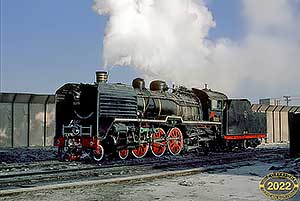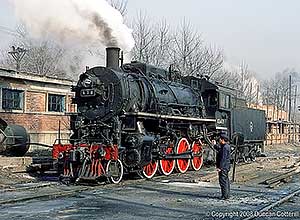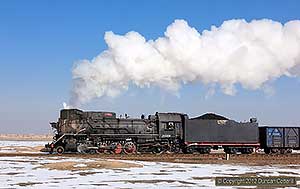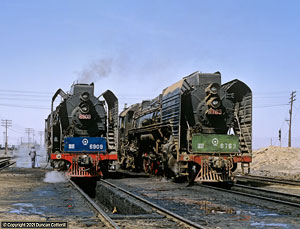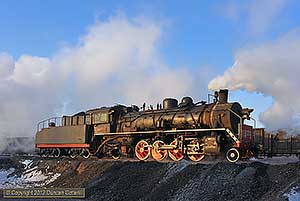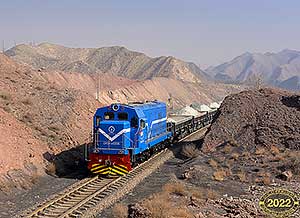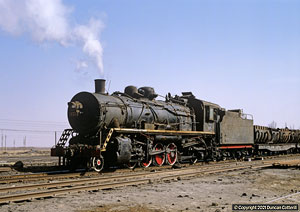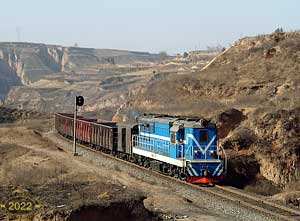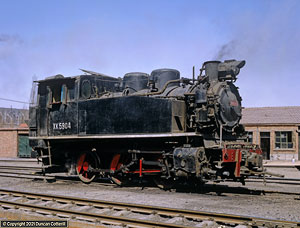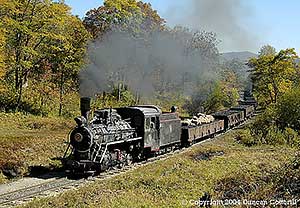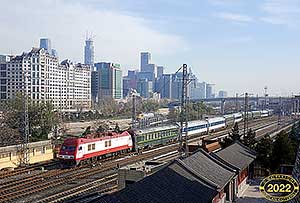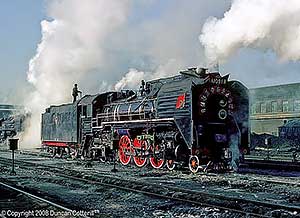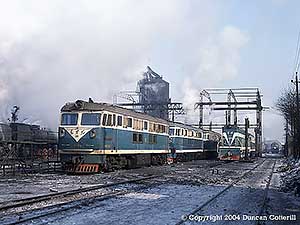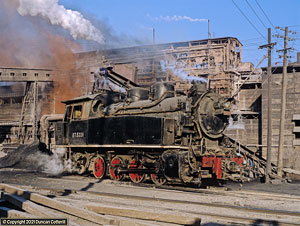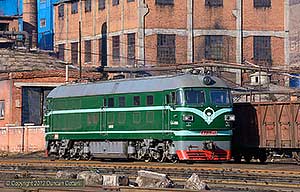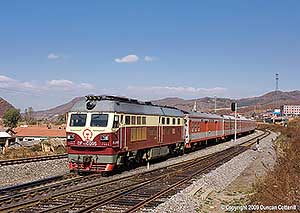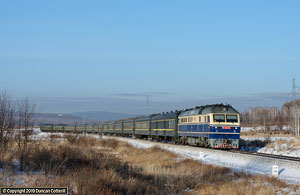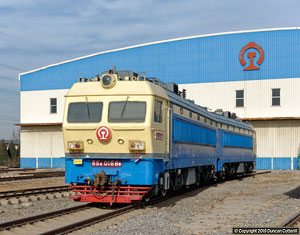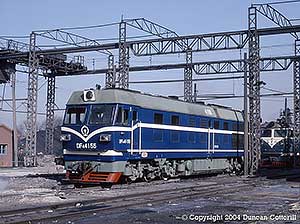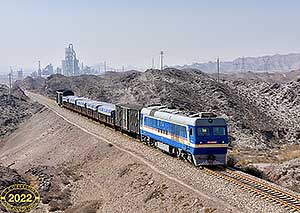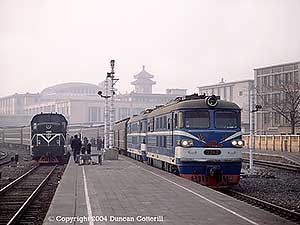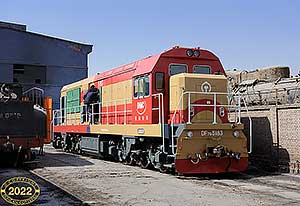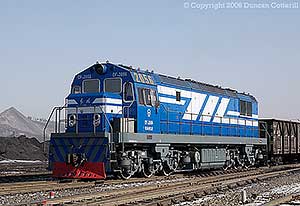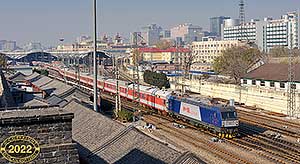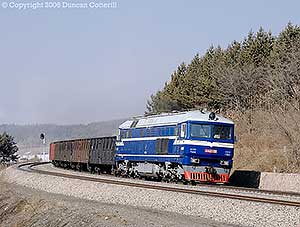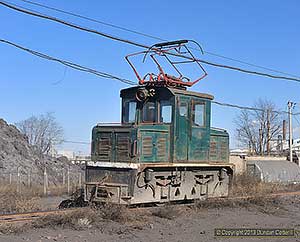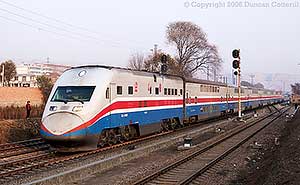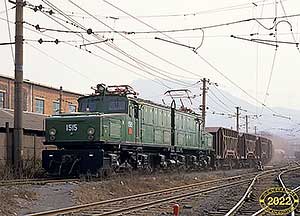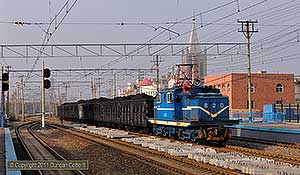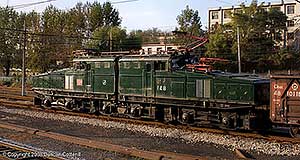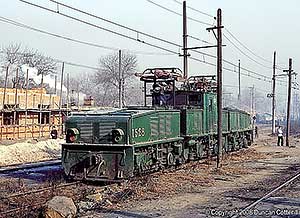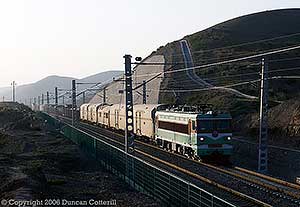SL6 Class 4-6-2
26 photos
updated : 2024-04-20
The SL6 Class 4-6-2 was one a number of Pacific classes introduced during the Japanese occupation of Manchuria, with a final batch built in the 1950s. Despite the SL6 being a much older design than the RM, they outlasted their younger cousins by a year with the last survivors working until 1991
KD6 Class 2-8-0
3 photos
updated : 2022-12-03
The KD6 Class consisted of at least 20 USATC 2-8-0s, a type commonly known as the S-160. The Chinese engines were
used in main line service initially but most had migrated to coal mines in the North-East by the 1980s. Most, if not all, received larger cabs and taller chimneys after arrival in China.
JS Class 2-8-2
362 photos
updated : 2022-12-03
The JS Class 2-8-2 was designed as a main line freight locomotive, a development of the JF Class 2-8-2s introduced on the SMR in 1918. The JS was in production at several different works from 1957 to 1988 and over 1900 were built. A handful remained in industrial service into the 2020s.
QJ Class 2-10-2
412 photos
updated : 2022-11-24
The QJ Class 2-10-2 was developed from the Soviet LV Class, probably based on the OR21 protoype that never went into production. Datong Works built over 4700 QJs from 1964 to 1988. The class worked main line freights all over China until the end of steam and could also be found on passenger trains.
SY Class 2-8-2
483 photos
updated : 2022-11-24
The SY Class 2-8-2 was China's standard industrial locomotive for the last few decades of the steam era. Over 1800 were built between 1960 and 1999, to a design derived from a 1920s ALCo light Mikado. The SYs were versatile machines and handful remained in industrial service until around 2018.
GKD1, GKD1A Class
7 photos
updated : 2022-11-24
The GKD1 and GKD1A classes of diesel-electric locomotive are Bo-Bo hood units built for industrial use by Dalian Locomotive Works. Power comes from a 6-cylinder inline version of the 240ZJ engine used in many classes including the DF4 family
JF Class 2-8-2
23 photos
updated : 2022-11-24
The JF Class 2-8-2 dates back to 1918 when ALCo supplied a batch 25 locos to the Japanese controlled SMR. By 1957 around 2000 locos had been built. Locos on the national system were still in use as shunters in the late 1980s but didn't last much longer. A few survived in industrial service until 2005.
DF7, DF7B/C/D/F Class
9 photos
updated : 2022-11-24
The DF7 classification covers a range of Co-Co diesel electrics produced by Beijing Feb 7th Works from 1981. Most were hood units intended for trip work and shunting and appear to have been relatively successful. A main-line version, the DF7D, was less successful and disappeared after a few years.
XK13 Class 0-6-0T
5 photos
updated : 2022-11-24
This 0-6-0T was the smaller of 2 classes of industrial tank locos supplied to the Chinese steel industry by Poland in the late 1950s and early 1960s. The XK13 was a standard Polish industrial design known as the T3A or "Ferrum 724" and up to 82 are thought to have been built for China by Fablok in 1958-60.
C2 Class NG 0-8-0
80 photos
updated : 2022-11-24
Most Chinese narrow gauge lines used 28 tonne 0-8-0 tender engines, usually known as C2s, and produced in quantity at Harbin and Shijiazhuang from 1958 to 1988. The design originated in Russia and some Chrzanow, Skoda and Mavag built locos ended up in China.
SS9, SS9G Class
6 photos
updated : 2022-11-06
A total of 43 SS9 and 173 SS9G 6400hp Co-Co electrics were built for fast passenger work by Zhuzhou between 1998 and 2006. The two variants look quite different but are similar technically. Both variants can be found working various routes from from Beijing and in the north-east.
RM Class 4-6-2
18 photos
updated : 2021-03-22
The RM Class 4-6-2 was China's final steam passenger design, combining a Russian designed boiler with a rolling chassis based on the earlier SL6 Pacific. A total of 258 were built between 1958 and 1966. Despite their relative youth, they were early victims of dieselisation with the last being withdrawn in 1990.
DFH3 Class
12 photos
updated : 2021-03-22
The DFH3 was a powerful twin-engined B-B diesel-hydraulic produced in the 1970s and 1980s and largely used to dieselise passenger trains in north-east China. They weren't the most reliable locomotives and were swept aside by the same tide of DF4s and electrification that finished off main line steam.
ET7 Class 0-8-0T
4 photos
updated : 2021-03-09
The ET7 Class 0-8-0 tanks were built in Poland around 1960 and worked in the Chinese steel industry until the mid 1990s. Some were rebuilt as tender engines.
DF4, DF4A, DF4B Class
74 photos
updated : 2020-11-13
All three classes are very closely related 3250hp Co-Co diesel-electrics, often lumped together as DF4s It would not be an exaggeration to say that the DF4 dieselised China. Well over 4000 were built from 1969 to the mid 1990s. DF4s are becoming rare in main line service but some continue on industrial lines.
DF4D, DF4DD Class
26 photos
updated : 2019-10-11
The DF4D was the final iteration of the successful DF4 line of Co-Co diesel-electrics and came in freight, passenger and high-speed versions. The class was introduced in 1996 with over 1300 built in total. Many are still in use today, working freight and passenger trains on non-electrified lines.
DF11 Class
7 photos
updated : 2019-10-11
The DF11 is a high powered Co-Co diesel-electric designed to haul fast passenger services on non-electrified lines. As electrification has spread, these locos have been deprived of much of the work they were intended for but they still work passenger services on many secondary main lines.
SS4, SS4G Class
6 photos
updated : 2019-10-11
The SS4 and SS4G, were similar twin unit Bo-Bo+Bo-Bo electrics built in quantity for heavy freight haulage. The classes used to be common on the lines north and east of Beijing, including the DaQin coal line but have recently been displaced by more modern designs of European origin.
DF4C Class
18 photos
updated : 2019-09-26
The DF4C was a development of the successful DF4B with a new, more angular bodystyle, a new blue livery and an uprated 16V240ZJC engine. They were quite common in northern China but rare in the south.
DF8B Class
10 photos
updated : 2017-03-10
The DF8B Co-Co diesel electric was a development of the DF8 but lacked the good looks of its predecessor. The class was built from 1997 at both Qishuyuan and Ziyang. It was a useful machine for heavy freight work, rated at 3680kW, and is still in widespread use on non-electrified lines.
BJ Class
9 photos
updated : 2017-03-09
The BJ was a compact powerful B-B diesel-hydraulic design equipped with a medium speed engine. The class was built at Beijing Feb 7th Works from 1975 to 1991 and dominated passenger traffic around the capital until the early 1990s. They were later cascaded to secondary lines before withdrawal.
DF7G Class
6 photos
updated : 2016-07-16
The DF7G is a Co-Co diesel electric designed for heavy shunting and trip work and uses a 12-cylinder version of the engine used in the DF4 series, making it considerably more powerful than the similar looking DF5. Locos are in service with the national railways and various industrial users.
DF5, DF5B, DF5D Class
15 photos
updated : 2016-07-16
The DF5 is a Co-Co diesel-electric for heavy shunting and trip working, powered by an 8-cylinder inline version of the engine used in the DF4. It comes in a number of variants and has found favour with the national railways and industrial operators.
HXD3B/3C/3D Class
4 photos
updated : 2016-07-16
The HXD3B, HXD3C and HXD3D Co-Co electric locomotives were built at Dalian from 2008 as a joint venture with Bombardier. The 3 classes are intended for freight, mixed traffic and passenger work respectively. Over 2000 have been built and they can be seen on electrified lines across China.
DF8 Class
9 photos
updated : 2016-07-16
The DF8 Class Co-Co diesel-electric dates from the same period as the DF4B but it was around 36% more powerful, making it ideal for heavy freight haulage. Some went to the Wuhan area but most were based at Mudanjiang, working coal trains from Jixi and Qitaihe to Harbin.
Narrow Gauge Electrics
6 photos
updated : 2016-07-16
Many industrial sites had their own narrow gauge electric railways, built to a variety of gauges, and there were a number of longer distance narrow gauge lines, usually at 762mm gauge. Locos came in all shapes, sizes and colours.
NYJ1, NZJ1, NZJ2 Class
4 photos
updated : 2016-07-16
China produced a number of diesel units in the 1990s to speed up passenger services on key routes. They followed the British HST concept with power cars permanently coupled to each end of a set of coaches. After a few years most had gone, replaced by true high-speed electric units or locos and coaches
EL1 & EL2 Class
5 photos
updated : 2016-07-16
The EL1s and EL2s were 1500V DC industrial electrics built by LEW at the former Borsig plant in East Germany and widely used in Eastern Europe and Russia as well as China. The EL1s were Bo+B'o+Bos with articulated bodies while the smaller EL2 Bo+Bo had a single section body.
ED85 Class
6 photos
updated : 2016-07-16
The ED85s are the oldest locomotives in use in China today. The design dates from the late 1920s and most of the survivors were built in the 1940s. They were still active on the Fushun opencast mining system in the early 2010s and, unusually for China, have worn several different liveries over the past 30 years.
ZG100 & ZG150 Class
5 photos
updated : 2016-07-15
The ZG100 and ZG150 were the local equivalents of the EL1 and EL2 and came in two versions, the ZG150-1500, a 2-section Bo+B'o+Bo, and the ZG100-1500, a single section Bo+Bo. They had noticeably longer noses and shorter full height sections than the LEW locos.
37E Class
5 photos
updated : 2016-07-15
These locos were similar, if not identical, to a large number of machines built by Skoda in the 1950s and 1960s for use on industrial railways in Eastern Europe and Russia. They consist of three separate 4-wheel units coupled together, eliminating the need for bogies and making them Bo'Bo'Bos.
SS3, SS3B Class
5 photos
updated : 2016-07-15
The SS3 and SS3B Co-Co electrics were built in large numbers from 1978 to 2006 as the electrified network grew. Although primarily a freight locomotive with a maximum speed of 100km/h, the locos have also seen use on passenger trains. They are still widespread in southern and western China.
It's difficult to comprehend the scale of China's railway system or the speed with which it's changed over the last few decades. The photos here are the result of dozens of visits to main line and industrial locations across the country since 1984 and depict many classes of steam, diesel and electric loco at work.




 options
options hide options panel
hide options panel